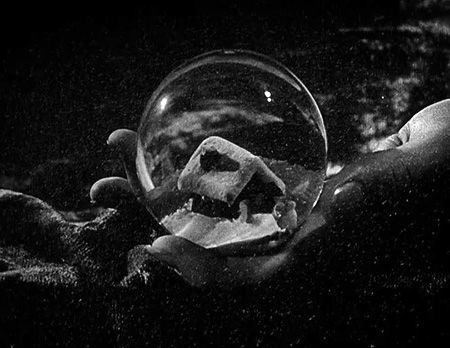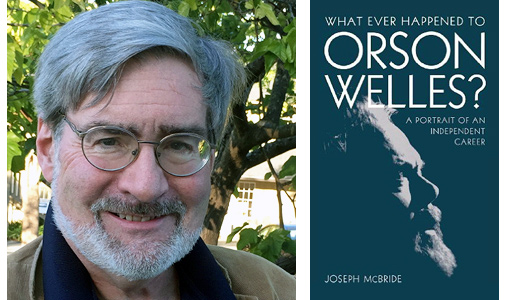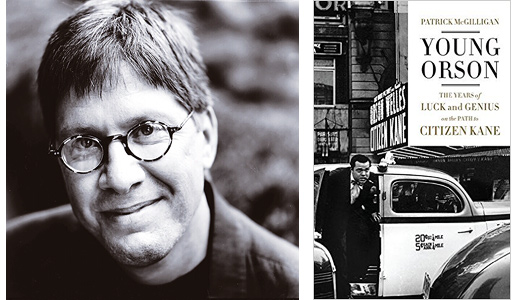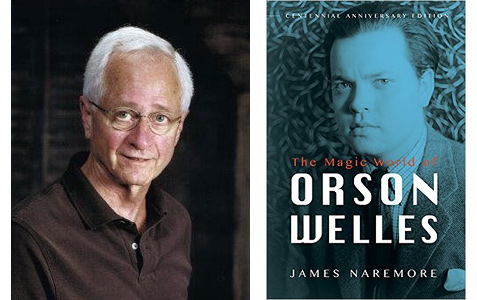“Citizen Kane towers over most other films. Few are in its league. It has a legacy for filmmakers as the film to beat, and for critics as one of the best of the best.” — Young Orson: The Years of Luck and Genius on the Path to Citizen Kane author Patrick McGilligan
The Digital Bits is pleased to present this retrospective commemorating the diamond anniversary of the release of Citizen Kane, Orson Welles’s legendary film about newspaper tycoon Charles Foster Kane and the pursuit of the meaning of “Rosebud.” [Read on here...]
As with our other celebratory articles, The Bits and History, Legacy & Showmanship offer this retrospective featuring a Q&A with an esteemed group of scholars and film historians who discuss the virtues, influence and legacy of Citizen Kane.
The participants (in alphabetical order)….
Joseph McBride is the author of three books on Orson Welles, most recently What Ever Happened to Orson Welles?: A Portrait of an Independent Career (University Press of Kentucky, 2006). McBride has written several other books, including Into the Nightmare: My Search for the Killers of President John F. Kennedy and Officer J. D. Tippit (Hightower Press, 2013), Frank Capra: The Catastrophe of Success (Touchstone, 1993), Steven Spielberg: A Biography (Simon & Schuster, 1997), Searching for John Ford (University Press of Mississippi, 2011), Hawks on Hawks (University of California, 1982), and Writing in Pictures: Screenwriting Made (Mostly) Painless (Vintage, 2012). McBride acted for Welles in The Other Side of the Wind (1970-76) and appears in his 1981 documentary Filming “The Trial”. His latest book is The Broken Places: A Memoir (Hightower Press, 2015), and he is currently working on a critical study of Ernst Lubitsch, How Did Lubitsch Do It?: The Films of Ernst Lubitsch. He is a co-writer of the screenplay for Rock ‘n’ Roll High School (1979). He is a professor in the School of Cinema at San Francisco State University. His website is josephmcbridefilm.com.
Patrick McGilligan is the author of Young Orson: The Years of Luck and Genius on the Path to Citizen Kane (HarperCollins, 2015). His other books include Clint: The Life and Legend (St. Martin’s, 2002), Alfred Hitchcock: A Life in Darkness and Light (It Books, 2004), Fritz Lang: The Nature of the Beast (University of Minnesota, 2013), and Jack Nicholson: The Joker is Wild (W.W. Norton & Company, 2015).
James O. Naremore is the author of The Magic World of Orson Welles (University of Illinois, 2015). He is Emeritus Chancellors’ Professor at Indiana University. His other books include More Than Night: Film Noir in its Contexts (University of California, 2008) and Charles Burnett: A Cinema of Symbolic Knowledge (due in 2017).
The interviews were conducted separately and have been edited into a “roundtable” conversation format.
---
Michael Coate (The Digital Bits): In what way is Citizen Kane worthy of celebration on its 75th anniversary?
Joseph McBride: Citizen Kane will always be “the film of films,” as François Truffaut has called it. He noted that it has “consecrated a great many of us to the vocation of cinéaste.” Including me. Though Kane did not create the new devices some people claim for it — it’s unwise to ever make that claim about a film, because you can always find a precedent — it is a treasure house of cinematic styles and devices and magic tricks, flamboyant and breathtakingly virtuosic and eloquent. The visual style that Welles put together with cinematographer Gregg Toland and other masterful technicians remains exhilarating no matter how often you’ve seen it — and I lost count after seeing it more than a hundred times. I now have to ration it to an occasional screening, because I know it by heart. Staying away for a while makes it seem more fresh. In a sense, Kane is as fresh as when it was made, a constant series of astonishments. More than that, the screenplay by Herman J. Mankiewicz and Welles is one of the greatest ever written, a profound character study and a multilayered narrative with brilliant dialogue, as richly textured as a novel. I also appreciated it for its savvy inside look at newspapers (my parents were reporters, as was I), and for its critique of the power of the media, which was ahead of its time. The film’s political insights into a fascist media baron were daring in 1941 (so much so that the film blighted Welles’s career in Hollywood and led to the FBI following him for fifteen years, which led to his blacklisting and exile), and are ever more timely today. I think what excited me as a youth were the style, the script, Welles’s youth when he made it (he was twenty-five when it was shot), and its daring. All that was inspirational, and still is.
Patrick McGilligan: Its 75th anniversary is one year off the centenary of Welles’s birth. That gives us two big reasons to celebrate Kane, along with our continuing appreciation for its greatness.
James O. Naremore: Film styles, modes of production, and modes of viewing are different today than when Kane first appeared — in fact, celluloid is no longer the chief basis of the medium. Then, too, the huge literature and debate around Kane has changed the way we see it. Donald Trump says it’s his favorite movie (I guess because he identifies with Charles Foster Kane). James Agee, Manny Farber, Jean-Paul Sartre, and Noel Burch have thought it over rated. Despite all this, I’d say Kane retains its stylistic fascination, youthful energy, satiric wit, and dramatic complexity. To analyze and discuss it at all, no matter what your opinion of its artistic qualities, is to realize that it’s one of the key pictures in the history of world cinema.
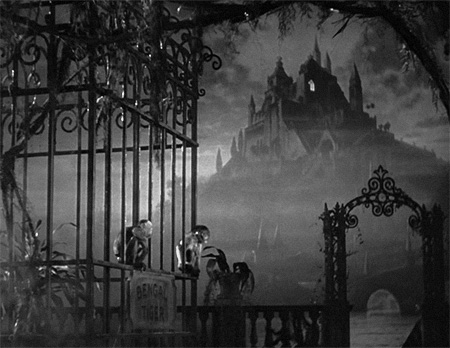
Coate: Can you describe your first viewing of Citizen Kane?
McBride: I first saw Kane in Professor Richard Byrne’s introductory film class at the University of Wisconsin, Madison, on September 22, 1966. It was a coup de foudre. I was nineteen, and it changed my life. I was an English major and had planned to write novels and work as a journalist. I did work as a journalist, and have continued doing so since 1960, but I changed my goal from writing novels to writing screenplays and books about films and wanting to direct films. When I told Welles I wanted to direct a film by the time I was twenty-five, as he did, he said kindly, “You will.” I eventually turned down three chances to direct films and realized I was better suited to being a writer. I worked as a screenwriter for 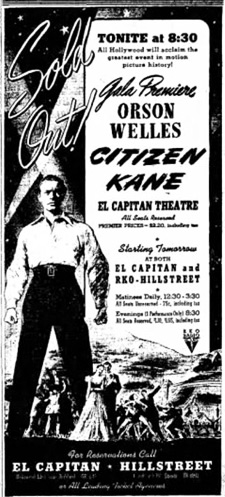 eighteen years but left that profession to write books fulltime, both on films and on other subjects…. I had started my first book (on baseball) in 1963, and wrote my first book on Welles (of three) from 1967 through 1971; Orson Welles was published in 1972 by the British Film Institute and the Viking Press. That project took over my life for four years, though I also worked on John Ford, a critical study I wrote with Michael Wilmington from 1969 through 1971. I obtained a 16mm print of Kane and watched it sixty times while writing the book on Welles. I found a copy of the screenplay at the Wisconsin Historical Society and lugged my portable typewriter there for a month to type an exact copy, since I couldn’t afford to Xerox it. I used the print and the script as my textbooks in my own curriculum of learning how to write films, direct films, and write about films. Our university had only three film courses, so after taking them I had to devise my own curriculum…. Orson Welles actually began as a book-length study of Kane, but after two years of work, I decided I needed to make it a full-length critical study of his entire body of work, since there wasn’t an adequate book on him in English. Shortly after I saw Kane, as it happened, the UW Memorial Union that fall had a series of six Welles films. I saw The Magnificent Ambersons and Touch of Evil, among others, for the first time, and realized there was much more to Welles than Kane. Some people still don’t realize that (fifty years later), which is why I’ve kept writing books on Welles. I am sure I will do another, called Orson Welles: The Last Word, when I am ninety. I’ve learned that once you start writing a book about someone, it never ends…. And Welles has been such an influence on my life. I also wrote Orson Welles: Actor and Director (1977), still the only book-length study of his acting career, which compelled me to see all the many (usually bad) films he acted in, and What Ever Happened to Orson Welles?: A Portrait of an Independent Career (2006). That book is partly a memoir of my work with Welles for six years as an actor on his still-unfinished roman à clef about Hollywood, The Other Side of the Wind, as a film critic and historian named Mister Pister, but What Ever Happened… is also an attempt to tell people all about what he was doing in the neglected last fifteen years of his life (1970-85), when he came back to Hollywood to live and work, the period when I knew him. In the process, I realized I had to tell the whole story of his career from new angles, showing people that (as film historian Douglas Gomery first proposed) he was always an independent filmmaker. He sometimes took advantage of the Hollywood studio system (as he did with RKO from 1939 until his firing in 1942) but was not a failed Hollywood director, as many in America think he was.
eighteen years but left that profession to write books fulltime, both on films and on other subjects…. I had started my first book (on baseball) in 1963, and wrote my first book on Welles (of three) from 1967 through 1971; Orson Welles was published in 1972 by the British Film Institute and the Viking Press. That project took over my life for four years, though I also worked on John Ford, a critical study I wrote with Michael Wilmington from 1969 through 1971. I obtained a 16mm print of Kane and watched it sixty times while writing the book on Welles. I found a copy of the screenplay at the Wisconsin Historical Society and lugged my portable typewriter there for a month to type an exact copy, since I couldn’t afford to Xerox it. I used the print and the script as my textbooks in my own curriculum of learning how to write films, direct films, and write about films. Our university had only three film courses, so after taking them I had to devise my own curriculum…. Orson Welles actually began as a book-length study of Kane, but after two years of work, I decided I needed to make it a full-length critical study of his entire body of work, since there wasn’t an adequate book on him in English. Shortly after I saw Kane, as it happened, the UW Memorial Union that fall had a series of six Welles films. I saw The Magnificent Ambersons and Touch of Evil, among others, for the first time, and realized there was much more to Welles than Kane. Some people still don’t realize that (fifty years later), which is why I’ve kept writing books on Welles. I am sure I will do another, called Orson Welles: The Last Word, when I am ninety. I’ve learned that once you start writing a book about someone, it never ends…. And Welles has been such an influence on my life. I also wrote Orson Welles: Actor and Director (1977), still the only book-length study of his acting career, which compelled me to see all the many (usually bad) films he acted in, and What Ever Happened to Orson Welles?: A Portrait of an Independent Career (2006). That book is partly a memoir of my work with Welles for six years as an actor on his still-unfinished roman à clef about Hollywood, The Other Side of the Wind, as a film critic and historian named Mister Pister, but What Ever Happened… is also an attempt to tell people all about what he was doing in the neglected last fifteen years of his life (1970-85), when he came back to Hollywood to live and work, the period when I knew him. In the process, I realized I had to tell the whole story of his career from new angles, showing people that (as film historian Douglas Gomery first proposed) he was always an independent filmmaker. He sometimes took advantage of the Hollywood studio system (as he did with RKO from 1939 until his firing in 1942) but was not a failed Hollywood director, as many in America think he was.
McGilligan: I saw Citizen Kane as a junior in high school. My older sister, by then a freshman in college, was taking a film class at the University of Wisconsin in Madison (which was only about a mile from where we lived), taught by Professor Russell Merritt. Kane was being screened. For some reason (it was unusual), I tagged along and was bowled over. For the first time I began to think seriously about film or, to put it differently, to take film seriously.
Naremore: I don’t remember the exact date, but I first saw it when it was re-released in the late 1950s. It played in a theater in Beaumont, Texas, about twenty miles from the Louisiana town where I lived. I was about fifteen years old and I travelled to Beaumont with an older friend who could drive. I had seen stills from Kane in Deems Taylor’s Pictorial History of the Movies (1950) and the idea of it filled me with high anticipation. I wasn’t disappointed, but I wasn’t overwhelmed. Certain images stuck with me: the dreamlike opening, the newsreel shot of Kane standing on a balcony with Hitler, the early newspaper scenes, and the “Raymond” episode. I don’t know if I could fully understand or appreciate such a film at that age, but I didn’t forget it.
